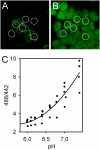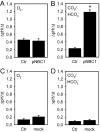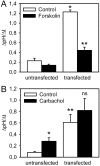cAMP-dependent and cholinergic regulation of the electrogenic intestinal/pancreatic Na+/HCO3- cotransporter pNBC1 in human embryonic kidney (HEK293) cells
- PMID: 19102757
- PMCID: PMC2625339
- DOI: 10.1186/1471-2121-9-70
cAMP-dependent and cholinergic regulation of the electrogenic intestinal/pancreatic Na+/HCO3- cotransporter pNBC1 in human embryonic kidney (HEK293) cells
Abstract
Background: The renal (kNBC1) and intestinal (pNBC1) electrogenic Na+/HCO3- cotransporter variants differ in their primary structure, transport direction, and response to secretagogues. Previous studies have suggested that regulatory differences between the two subtypes can be partially explained by unique consensus phosphorylation sites included in the pNBC1, but not the kNBC1 sequence. After having shown activation of NBC by carbachol and forskolin in murine colon, we now investigated these pathways in HEK293 cells transiently expressing a GFP-tagged pNBC1 construct.
Results: Na+- and HCO3-dependent pHi recovery from an acid load (measured with BCECF) was enhanced by 5-fold in GFP-positive cells compared to the control cells in the presence of CO2/HCO3-. Forskolin (10(-5) M) had no effect in untransfected cells, but inhibited the pHi recovery in cells expressing pNBC1 by 62%. After preincubation with carbachol (10(-4) M), the pHi recovery was enhanced to the same degree both in transfected and untransfected cells, indicating activation of endogenous alkalizing ion transporters. Acid-activated Na+/HCO3- cotransport via pNBC1 expressed in renal cells is thus inhibited by cAMP and not affected by cholinergic stimulation, as opposed to the findings in native intestinal tissue.
Conclusion: Regulation of pNBC1 by secretagogues appears to be not solely dependent on its primary structure, but also on properties of the cell type in which it is expressed.
Figures





References
-
- Ruiz OS, Arruda JA. Regulation of the renal Na-HCO3 cotransporter by cAMP and Ca-dependent protein kinases. Am J Physiol. 1992;262:F560–F565. - PubMed
-
- Bachmann O, Rossmann H, Berger UV, Colledge WH, Ratcliff R, Evans MJ, et al. cAMP-mediated regulation of murine intestinal/pancreatic Na+/HCO3-cotransporter subtype pNBC1. Am J Physiol Gastrointest Liver Physiol. 2003;284:G37–G45. - PubMed
Publication types
MeSH terms
Substances
LinkOut - more resources
Full Text Sources

